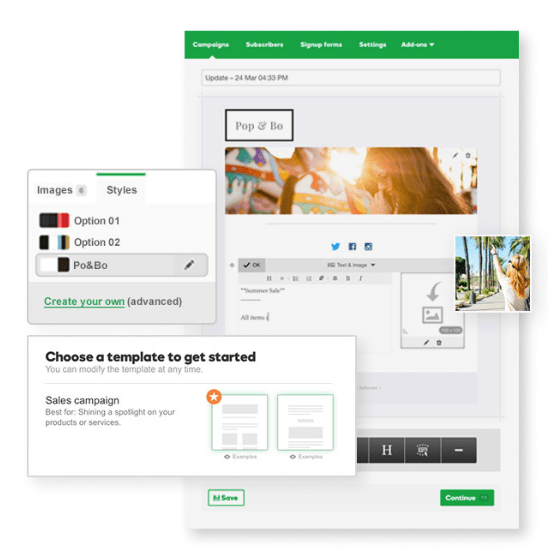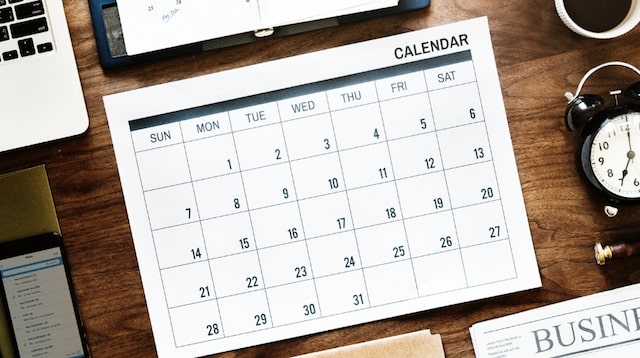Email newsletters are a powerful marketing tool for your business. They’re cheap to create and send, and they bring in paying customers. In fact, email newsletters are one of the best-performing tools for return on investment.
Australia and New Zealand have the most engaged email recipients in the world.
But how often do you think “I just don’t know what to write in my newsletter?” Fear not, we’ve got fresh ideas for a variety of industries, from art and design to professional services like law and finance. Read on and be inspired.
Newsletter ideas for 5 of our favourite industries
When it comes to results, email newsletters deliver. But what to write about? Read our ideas for these five industries.
-
Home services.
-
Fashion.
-
Health and medical.
-
Art and design.
-
Professional services.
Dip into these ideas for your next newsletter.
Email newsletter ideas for your business

Photo: Toa Heftiba on Unsplash
Email newsletters are highly effective but they do require a commitment — you have to keep sending new ones out. And you don’t want to keep writing about the same old things or people will stop reading. Check out these suggestions.
1. Home services
Home services newsletters should focus on how you make your customers’ lives easier. You can include helpful home tips, or better yet, suggestions for things they could do with their time if they outsource the cleaning/ironing/shopping/dog washing to you!
- Time saving tips: How to be more productive and efficient at home.
- Money saving tips: Tasty cheap recipes, how to upcycle, selling on eBay.
- How to declutter: Before-and-after photos are popular because they prove the outcome is worth the effort.
- DIY instructions or craft project ideas: How to restore furniture or make a floral arrangement.
- Best free online resources: Collections of links to kids’ activities, recipes, gift ideas.
The referral bonus is a tried-and-true tactic and one worth mentioning in every other newsletter. Ask your customers to recommend you to a friend; if the friend buys your service, the original customer gets a thank-you bonus or discount.
Pro tip: Word-of-mouth is powerful marketing because customers trust what their friends like.
2. Fashion

Photo: ROBIN WORRALL on Unsplash
A fashion newsletter showcases your brand’s style and positions it as a desirable icon. Plus it’s a great vehicle for lifestyle photos of models wearing your clothing and accessories. (Get tips on taking great product photos here).
A couple of themes to try:
- Sneak peek: New collection launch.
- Style watch: How to emulate the style of your favourite celebrity looks using pieces you sell.
- Seasonal trends: What’s popular for the coming season.
- Birthday offer: Invite customers to subscribe to receive a discount in their birthday month.
- Exclusive sales and offers: Upcoming events, bonuses or discounts for email subscribers only.
Pro tips: Using codes for discount offers makes it easy to track the effectiveness of a campaign, so you can repeat the winners. If you use the phrase “sneak peek” in your email, be careful of the spelling — it’s not sneak peak like you see on IG all the time!
3. Health and medical
Your health or medical newsletter is a chance to show patients that you’ve got their best interests in mind. It’s also a great way to lead patients toward healthier habits.
- Life-saving health information and warning signs, such as “How to tell if someone is having a stroke” or links to local first aid courses.
- Seasonal reminders: “It’s time to get your annual flu vaccination.”
- Relaxation tips: How to switch off and rest properly.
- Food tips: Healthy and delicious recipes on a theme, such as vegetarian, healthy snacks, fish, kids’ meals, summer salads.
- Exercise tips: Workouts you can do at home like bodyweight squats, push ups and lunges.
An ounce of prevention is worth a pound of cure and no one know this better than healthcare professionals. Use your newsletter to teach patients about their own health.
4. Art and design
As an artist or designer, you’re making beautiful things, so sharing photos is your most powerful marketing tool. But fans are also curious about the process an artist goes through to create his or her work.
- Inspirations: Beautiful things you have seen that inspired your work this week.
- Case study: Write about a custom art piece, graphic design or illustration you completed. Include a testimonial or comment from the happy client if you can.
- Photo gallery: What’s new in your studio, new creations or themes in your art.
- Art events: Links to major public exhibitions such as NGV or National Gallery, small local artist events and your own exhibitions.
- Processes: A snapshot of your favourite materials, tools and techniques.
- Time-lapse: Take a time-lapse video of your creation and share it with subscribers.
Stories are also a useful tool for artists and designers — describe when you knew you would be an artist, how you chose your medium, why you love graphic design, etc.
5. Professional services
If you’re a lawyer, accountant or financial planner, the fact is that some of your clients won’t understand a lot about what you do and how you do it. Your email newsletter is a chance to explain to clients, in everyday language, how you can help them.
- Team member profile: A brief introduction and photo of individual staff members.
- Deadline reminders: Provide dates for tax return submissions or super contributions.
- Explainers: Unpack complicated industry terms in a way that’s easy to understand. Choose something that’s been in the news lately that customers might be curious about.
- Infographics: How about a step-by-step guide to the legalities of buying a house, or starting a company or getting a divorce? Start with your most common enquiries from clients about “How do I…?”
- Ways to save money: Use real examples (without names, of course) of how your clients got out of debt, cut down on expenses or saved a house deposit. Client testimonials saying how you helped are worth their weight in gold.
The goal here is to explain a little of the jargon of your profession so readers can make informed decisions. Don’t be afraid to talk about events in the news, especially if you can tie them back to an issue of concern to many of your clients.
Which tools can I use to send email newsletters?
You don’t need an entire team to run an email marketing campaign for a small business; you simply need a great email marketing tool.
Check out these industry leaders to find the best fit for your business:
Here are just a few things the best email marketing tools offer:
An easy way to gather email sign-ups
You can’t send out a newsletter if you have no one to send it to, so most email tools include pop-up or static sign-up forms that invite website visitors to subscribe. There are some pop-ups that are activated when a reader motions their mouse upwards towards the X Close button. These are less intrusive than pop-ups that appear within a few seconds of opening the page — “Why should I sign up when you haven’t given me enough time to read and decide if I want to sign up?”
Beware of forcing a pop-up on mobile devices, and full-screen pop-ups on desktop; Google penalises websites that use pop-ups (or interstitials) because they are annoying.
Editor’s note: You can easily build a website with GoDaddy and utilize the email marketing tool to add a newsletter signup form to your home page with just a few clicks.
Professionally designed templates
Many email tools provide example templates to save you time. Some email marketing systems have drag-and-drop builders so you can customise the email’s appearance to suit your brand. The email marketing tool included with GoDaddy's eCommerce website builder automatically generates an email template that matches the look of your GoDaddy website.
 Email Automation
Email Automation
This feature allows you to program emails to send automatically, freeing you for more important tasks. You can send an automatic welcome newsletter to new subscribers, reminders for offers and “abandoned cart” emails to capture lost sales.
Insight into how your emails are being received
Analytics provided by all the major email marketing tools, including GoDaddy Email Marketing, enable you to monitor the performance of your newsletters.
You can see how many people open specific newsletters, how many click and track customers all the way to purchase. You can test different Subject lines and different send times to check which are most popular. These numbers show you how to continuously improve your email newsletters for better and better responses.
What are the rules about sending email newsletters?
Australia has strict anti-spam laws, so you need to make sure that your email newsletter complies. You can read the details of the Spam Act 2003 here, but these are the key points:
Consent to receive
No, you can’t just export all the contacts in your address book to your newsletter list. Subscribers must voluntarily agree or “opt-in” to receive your newsletter — or any email for that matter. A double opt-in system, where the user says ‘yes’ twice, is best.
Identity of sender
To avoid being labelled as spam, all emails must accurately identify the business (or person) that sent it.
Option to unsubscribe
Every email newsletter you send must include a clear way to get off the list. Keep your unsubscribe process simple. Nothing is more infuriating for a customer than a multistep unsubscribe process.
It is also your responsibility to protect any customer data that you collect. This means you need to take reasonable steps to prevent hacking and theft of customer information like names, addresses, email addresses and phone numbers. If you have an eCommerce or login website, you must also protect customers’ passwords and credit card information.
Editor’s note: Emails sent with GoDaddy Email Marketing meet all of these requirements.
How often should you send email newsletters?
The right timing and frequency for email newsletters is a fine balance, and it’s different for every business. The most common reason for unsubscribes are “too many emails” and “this isn’t relevant to me.”
For many businesses, once a month is enough; others prefer weekly. Consider how quickly your industry changes, and how often you’ve got something interesting to say. Be regular and consistent and see what happens.
If you start to see unsubscribes rise, either you’re emailing too often, or the content isn’t interesting or useful to your customers. Use the analytics to guide you, and if you’re not sure, engage a marketing expert in your field.
Top three tips on email newsletter timing:
- Experiment with different days and times to see when your readers open your emails.
- Create a calendar mapping out the newsletters you plan to send this year. Include relevant industry dates, special events and your sales offers. Choose a frequency that you can stick to. Start with once or twice a month and adjust if necessary.
- Keep it short. Each email should take no more than three to five minutes to read. Shorter is better if you’re sending weekly.
Get started
Are you brimming with ideas and feeling inspired to try email newsletters for your business? Get started with GoDaddy Email Marketing. There are three different plan levels, so you can grow your newsletter as your business grows. Be sure to add a call-to-action to every email that sends readers to your website — or even a specific page of your site — for more information or to make a purchase. Best of luck!






